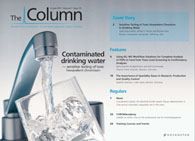The Real Thing?
A process has been developed that uses combinational peptide ligand libraries to determine whether Cola drinks have been flavoured using natural vegetable extracts or only with artificial chemical flavourings.
A process has been developed that uses combinational peptide ligand libraries to determine whether Cola drinks have been flavoured using natural vegetable extracts or only with artificial chemical flavourings.
Original Cola recipes used nuts from the Kola tree, which are native to West Africa and act as a source of caffeine in the drinks. Most modern soft drink manufacturers artificially replicate the flavour of kola nuts in their recipes; but there are some that claim to use the natural ingredient and charge a premium for it.
Using combinational peptide ligand libraries, researchers investigated the proteome of a Cola drink to see if these plant extracts could be detected.1 By treating large beverage volumes (1 L) and performing the capture with the libraries at very acidic pH values (pH 2.2) under conditions that mimicked reverse-phase adsorption, the study found traces at the 15–20 kDa range. These were analysed using nano-LC–MS–MS and were identified as plant proteins. At the same time, Coca Cola products, which do not claim to contain kola extracts, were found not to contain the proteins.
The study concluded that the technique could be used to ascertain the presence of proteins from plant extracts and suggests that it could give the beverages a quality mark and certificate of authenticity.
1. A. D’Amato et al., J. Proteome Res., 10, 2684–2686 (2011).
This story originally appeared in The Column. Click here to view that issue.

New Study Reviews Chromatography Methods for Flavonoid Analysis
April 21st 2025Flavonoids are widely used metabolites that carry out various functions in different industries, such as food and cosmetics. Detecting, separating, and quantifying them in fruit species can be a complicated process.
Analytical Challenges in Measuring Migration from Food Contact Materials
November 2nd 2015Food contact materials contain low molecular weight additives and processing aids which can migrate into foods leading to trace levels of contamination. Food safety is ensured through regulations, comprising compositional controls and migration limits, which present a significant analytical challenge to the food industry to ensure compliance and demonstrate due diligence. Of the various analytical approaches, LC-MS/MS has proved to be an essential tool in monitoring migration of target compounds into foods, and more sophisticated approaches such as LC-high resolution MS (Orbitrap) are being increasingly used for untargeted analysis to monitor non-intentionally added substances. This podcast will provide an overview to this area, illustrated with various applications showing current approaches being employed.

.png&w=3840&q=75)

.png&w=3840&q=75)



.png&w=3840&q=75)



.png&w=3840&q=75)






